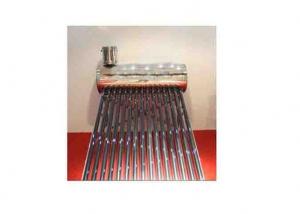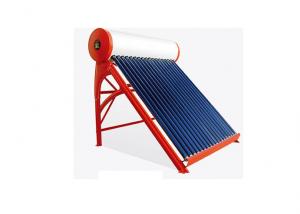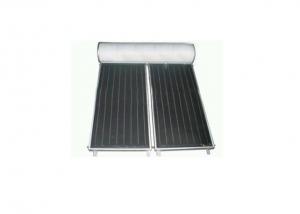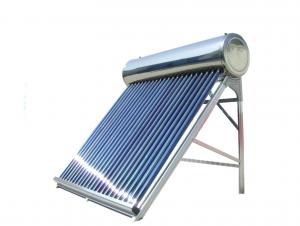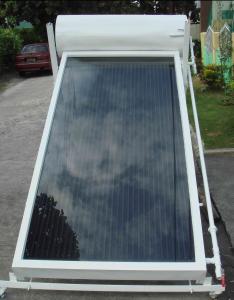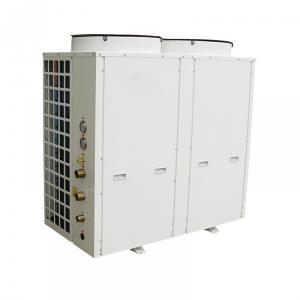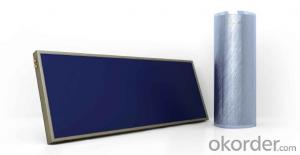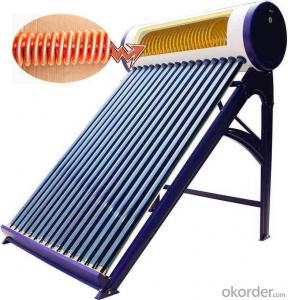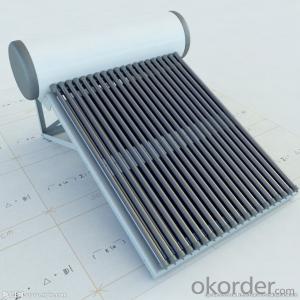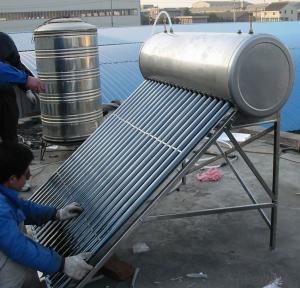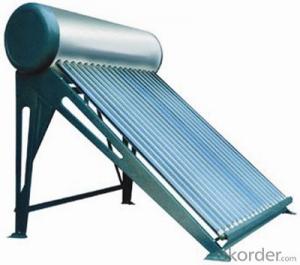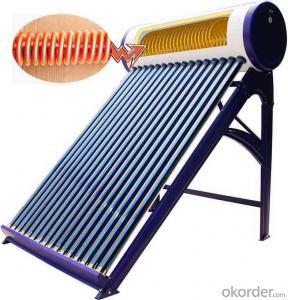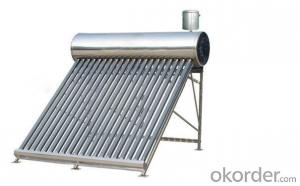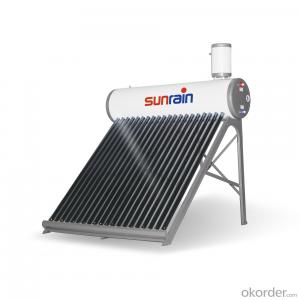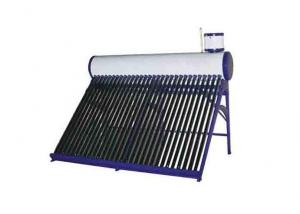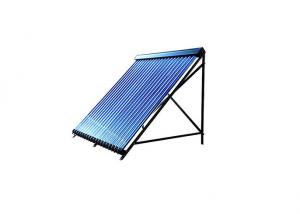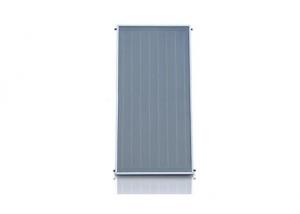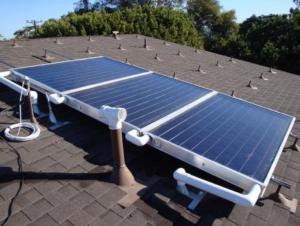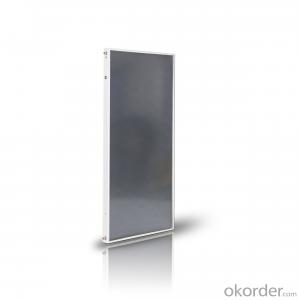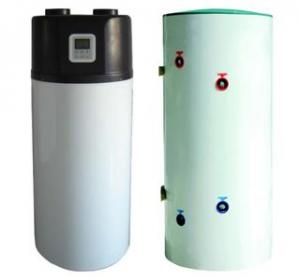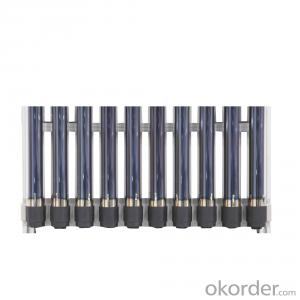Heat Exchanger Solar Water Heater (HYV8) - New Stainless Steel Non-Pressurized Model
- Loading Port:
- China Main Port
- Payment Terms:
- TT or LC
- Min Order Qty:
- 20 Set set
- Supply Capability:
- 2000 Sets per Month set/month
OKorder Service Pledge
OKorder Financial Service
You Might Also Like
Detailed Product Description
*Latest style & Hot sale style
*material of inner & outer tank: stainless steel SUS-2B 304
*automatically water supply
*Non-pressurized Solar Energy Water Heater
(It is specially designed for the acid rain area, since it is stainless steel outer tank material .
*SUS304-2B stainless steel inner tank material(310mm/360mm diameter, thickness:0.4mm )
*SUS304-2B stainless steel outer tank matetial(420mm/460mm diameter thickness:0.4mm)
*50mm/55mm thickness insulation with polyuthane foaming
*Capacity: 100L 150L 200L 300L etc
*assistant tank:5L
*SUS304-2B stainless support stand
*support angle: 27 / 45/ etc
*Vacuum tube style: Three-target & sealed glass style
*Vacuum tube size: 47*1500mm, 58*1800mm
*specific absorption: as=090-0.94
*average heat loss coefficient : Ult 0.6W
*Resistence to rain hail & acid rail
*easy installation
*lifespan: 15 years
*10 years warranty
- Q: I am in the north, the winter is coming, the family of a solar water heater, solar water heater and a radiator to connect, realizes the indoor heating, there is no one to do this kind of transformation, how to realize the water cycle?Is there any way to reduce the carbon heating in the northern region in winter?
- Solar water heater and radiator can be connected.1, solar water heater in the sun when the water temperature can reach 80 degrees, can meet the heating requirements;2, due to the instability of the solar energy, the need for auxiliary heat source, in the absence of the sun when the heating system heating;
- Q: What is the impact of nearby buildings or structures on the performance of a solar water heater?
- The impact of nearby buildings or structures on the performance of a solar water heater can vary depending on several factors. Firstly, the position and orientation of nearby buildings can affect the amount of sunlight that reaches the solar water heater. If the buildings are tall and obstruct the path of sunlight, it can significantly reduce the amount of solar radiation reaching the solar panels, thus affecting the efficiency of the system. However, if the buildings are positioned in a way that allows for maximum exposure to sunlight, the performance of the solar water heater can be enhanced. Secondly, nearby buildings can create shading patterns that change throughout the day. This can cause fluctuations in the temperature of the solar panels, which may affect the overall performance of the system. If the shading is intermittent and minimal, the impact may be negligible. However, if the shading is constant and covers a significant portion of the solar panels, it can result in reduced heat absorption and lower water heating efficiency. Additionally, the presence of nearby structures can also impact the wind patterns around the solar water heater. If the buildings create wind tunnels or block the airflow, it can affect the cooling capacity of the system. Proper ventilation is crucial for efficient heat dissipation, so any obstruction to the airflow can potentially decrease the performance of the solar water heater. Moreover, the proximity of nearby buildings can affect the maintenance and cleaning process of the solar water heater. If the buildings are too close, it may be challenging to access and maintain the system, which can lead to a decrease in performance over time. In conclusion, nearby buildings or structures can have both positive and negative impacts on the performance of a solar water heater. It is important to consider factors such as sunlight exposure, shading patterns, wind patterns, and maintenance accessibility when installing the system to maximize its efficiency.
- Q: Can a solar water heater be used in areas with restrictions on rooftop installations?
- Yes, a solar water heater can be used in areas with restrictions on rooftop installations. While rooftop installations are the most common and efficient way to harness solar energy for water heating, there are alternative options available. One option is to install the solar water heater on the ground, either in the backyard or any suitable open area. Ground installations can be done using a rack or a stand specifically designed for solar water heaters. Another option is to install the solar water heater on a wall or a freestanding structure, such as a shed or a carport. These alternative installations may require additional equipment and adjustments, but they can still effectively utilize solar energy to heat water while adhering to any restrictions on rooftop installations. It's important to consult with a professional installer to determine the best alternative installation option for specific restrictions and conditions.
- Q: Solar water heater water pipe with plastic tube or PPR tube good
- Aluminum plastic pipe is a kind of middle longitudinal welded aluminum pipe, the inner and outer layer of polyethylene plastic and between layers of hot melt adhesiveA new type of composite pipe. Polyethylene is a non-toxic, odorless plastic, with good impact resistance, corrosion resistance, weather resistance. The compressive strength of the middle layer longitudinal welding Aluminum Alloy tube with metal, the impact resistance of the pipe is easy to bend rebound, aluminum-plastic composite pipe with metal pipe and plastic pipe two strong pressure characteristics of anti acid corrosion resistance, is a model of a new generation of pipe. Plastic pipe (plastic composite pipe) is a kind of pipe is more popular on the market, the current market there are relatively well-known HSBC, Kim and Meifeng, due to its lightweight, durable and convenient for construction, and the aluminum pipe (plastic composite pipe) can bend more suitable for use in the home.
- Q: How much space is required to install a solar water heater?
- The space required to install a solar water heater can vary depending on the size and type of the system. Generally, a typical solar water heater requires around 10-15 square feet of roof space for installation. However, it's recommended to consult with a professional installer to determine the exact space requirements for your specific system.
- Q: Are there any health benefits associated with using a solar water heater?
- There are multiple health benefits associated with the use of solar water heaters. One of the main advantages is the decrease in exposure to harmful chemicals and toxins that are present in traditional water heating systems. Unlike traditional methods that rely on fossil fuels like natural gas or oil, solar water heaters utilize clean and renewable solar energy. This eliminates the release of harmful emissions during the heating process, resulting in improved indoor air quality and a reduced risk of respiratory problems. Furthermore, solar water heaters help prevent the growth of harmful bacteria and microorganisms in the water supply. Unlike traditional heaters that store hot water in tanks, which can create an environment suitable for the growth of Legionella bacteria and other pathogens, solar water heaters heat water on-demand. This minimizes the risk of bacterial contamination and decreases the chances of waterborne diseases. Additionally, the use of solar water heaters can positively impact skin health. Traditional water heating systems often rely on hard water, which contains high levels of minerals like calcium and magnesium. These minerals can dry out the skin and hair, leading to issues such as dryness, itchiness, and dandruff. However, solar water heaters can be equipped with water softening systems that remove these minerals. This results in softer and healthier skin and hair. Finally, the use of solar water heaters can contribute to overall mental and emotional well-being. By reducing reliance on non-renewable energy sources, individuals can feel a sense of satisfaction and pride in their contribution to a healthier and more sustainable environment. This positive mindset can have a cascading effect on mental health, improving mood, reducing stress, and promoting overall well-being. In conclusion, solar water heaters offer various health benefits, including reduced exposure to harmful chemicals, prevention of bacterial contamination, improved skin health, and positive impacts on mental well-being. By harnessing the power of the sun, solar water heaters provide a sustainable and health-conscious solution for water heating.
- Q: Can a solar water heater be connected to an existing water heating system?
- Yes, a solar water heater can be connected to an existing water heating system. This can be done by adding a heat exchanger to the existing system, which allows the solar water heater to supplement or even replace the traditional heating source.
- Q: What are the installation requirements for a solar water heater's expansion tank?
- The installation requirements for a solar water heater's expansion tank may vary depending on the specific model and manufacturer. However, there are some general guidelines that are typically followed. Firstly, it is important to ensure that the expansion tank is installed in a location where it can easily be accessed for maintenance and inspection. This may involve providing adequate clearance around the tank and ensuring that it is not obstructed by other equipment or structures. The expansion tank should be installed on the cold water supply line, typically near the inlet of the solar water heater. This allows it to effectively absorb the increased volume of water when it expands due to heating. It is important to follow the manufacturer's instructions regarding the specific location and orientation of the tank. In terms of plumbing, the expansion tank should be connected to the cold water supply line using appropriate fittings and connectors. It is essential to use high-quality, leak-proof connections to prevent any water leaks. The tank may also require a pressure relief valve to ensure that the system does not become over-pressurized. The expansion tank should be properly supported and secured to prevent any movement or damage. This may involve using brackets or straps to secure the tank to a wall or other stable structure. Before installing the expansion tank, it is recommended to consult the manufacturer's instructions and guidelines to ensure that all specific requirements are met. Additionally, it is often beneficial to consult with a professional plumber or solar water heater installer to ensure that the installation is done correctly and in compliance with local codes and regulations.
- Q: How efficient are solar water heaters?
- Solar water heaters are highly efficient as they convert sunlight into heat energy without the need for electricity or fuel. They can provide hot water throughout the year, with efficiency rates typically ranging from 60% to 80%, resulting in substantial energy and cost savings.
- Q: What are the advantages of using a solar water heater?
- There are several advantages to using a solar water heater. Firstly, it helps to reduce energy consumption and dependence on fossil fuels as it harnesses the sun's free and renewable energy. This can lead to significant cost savings on electricity or gas bills. Secondly, solar water heaters are environmentally friendly, producing lower greenhouse gas emissions compared to traditional water heaters. Additionally, they require minimal maintenance and have a longer lifespan, resulting in reduced overall costs and a smaller carbon footprint. Finally, solar water heaters can be a reliable source of hot water even during power outages, ensuring a continuous supply.
1. Manufacturer Overview
| Location | Zhejiang,China (Mainland) |
| Year Established | 2004 |
| Annual Output Value | US$10 Million - US$50 Million |
| Main Markets | North America; South America; Southeast Asia; Africa; Oceania; Mid East; Western Europe |
| Company Certifications | ISO 9001:2000 |
2. Manufacturer Certificates
| a) Certification Name | |
| Range | |
| Reference | |
| Validity Period |
3. Manufacturer Capability
| a) Trade Capacity | |
| Nearest Port | |
| Export Percentage | 61% - 70% |
| No.of Employees in Trade Department | |
| Language Spoken: | |
| b) Factory Information | |
| Factory Size: | 5,000-10,000 square meters |
| No. of Production Lines | 8 |
| Contract Manufacturing | OEM Service Offered |
| Product Price Range | |
Send your message to us
Heat Exchanger Solar Water Heater (HYV8) - New Stainless Steel Non-Pressurized Model
- Loading Port:
- China Main Port
- Payment Terms:
- TT or LC
- Min Order Qty:
- 20 Set set
- Supply Capability:
- 2000 Sets per Month set/month
OKorder Service Pledge
OKorder Financial Service
Similar products
Hot products
Hot Searches
Related keywords
